Should you tint your car windows?
The Pros and Cons of Window Tinting
Window tinting, the process of applying a thin film to the interior or exterior of a vehicle’s glass surfaces, has become increasingly popular among car owners. This practice, often seen as a stylish enhancement, serves several practical purposes. However, like many modifications, it comes with its own set of advantages and disadvantages. This article delves into the pros and cons of window tinting to help you make an informed decision.
The Pros of Window Tinting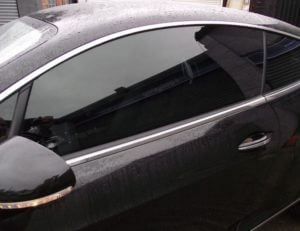
1. UV Protection— One of the primary benefits of window tinting is its ability to block harmful ultraviolet (UV) rays. Prolonged exposure to UV rays can cause skin cancer and other skin-related issues. Tinted windows can block up to 99% of these rays, offering significant protection for the vehicle’s occupants.
2. Heat Reduction— Window tinting can substantially reduce the amount of heat entering a vehicle. This is particularly beneficial in hot climates, where the interior of a car can become unbearably hot. By blocking a significant portion of the sun’s heat, tinted windows help maintain a cooler temperature inside the car, enhancing comfort and reducing the need for air conditioning.
3. Glare Reduction— Glare from the sun or headlights of other vehicles can be a major distraction and a safety hazard while driving. Tinted windows reduce this glare, allowing for a more comfortable and safer driving experience, particularly during sunrise, sunset, and night driving.
4. Privacy and Security— Tinted windows provide an additional layer of privacy for the occupants of a vehicle. Passersby cannot easily see inside the car, which can deter potential thieves. Valuables left inside the vehicle are less visible, reducing the likelihood of a break-in.
5. Aesthetic Appeal— For many, window tinting enhances the visual appeal of a vehicle. It gives the car a sleek, stylish look that many find attractive. This can also potentially increase the resale value of the car, as a well-maintained, aesthetically pleasing vehicle may attract more buyers.
6. Protection of Interior— UV rays can cause the upholstery, dashboard, and other interior surfaces to fade and crack over time. Window tinting helps protect the interior of the car by blocking these rays, thereby prolonging the life and appearance of the vehicle’s interior.
The Cons of Window Tinting
1. Legal Restrictions— One of the primary drawbacks of window tinting is the legal restriction associated with it. Different regions have varying laws regarding the permissible level of tint on vehicle windows. Exceeding these limits can result in fines, penalties, and even mandatory removal of the tint. It’s crucial to be aware of and comply with local regulations to avoid legal issues.
2. Reduced Visibility— While window tinting reduces glare, it can also reduce overall visibility, especially at night or in low-light conditions. This can make it more difficult to see the road, pedestrians, or obstacles, potentially increasing the risk of accidents. It is essential to balance the level of tint to ensure it doesn’t impair visibility.
3. Quality and Installation Issues— The effectiveness and durability of window tinting depend largely on the quality of the tint film and the skill of the installer. Poor-quality films can bubble, peel, or discolor over time, detracting from the car’s appearance and requiring costly replacements. Additionally, improper installation can lead to air bubbles, uneven application, and reduced effectiveness.
4. Potential for Increased Attention from Law Enforcement— Vehicles with heavily tinted windows may attract more attention from law enforcement officers, who may suspect illegal activities or non-compliance with tinting laws. This can lead to frequent stops and checks, which can be inconvenient and stressful for the driver.
5. Interference with Electronic Devices— Some window tint films, particularly metallic or hybrid tints, can interfere with electronic signals. This can affect the functionality of GPS devices, mobile phones, radios, and other electronic equipment. It’s important to choose a tint that does not interfere with these devices, especially if you rely heavily on them.
6. Cost— Professional window tinting can be expensive, depending on the quality of the film and the vehicle’s size. While it is a worthwhile investment for many, the initial cost can be a deterrent. Additionally, if the tint needs to be replaced due to damage or legal issues, it can add to the overall expense.
down the degradationof the plastics and fabrics used in your vehicle.
• Tinted windows reduce cabin temperature
Depending on the degree of tinting you choose, window tinting film can also reduce the interior temperature of your vehicle by up to 70%. That’s a big advantage, especially in warm sunny climates.
• Tint film reduces glass shatter
Car window tinting film also reduces the effects of glass shatter if the window is ever broken. The windshield glass is laminated so it doesn’t shatter. Door glass isn’t laminated but it is tempered. If the door window glass is struck it will break into small pieces instead of shards, but because it’s not laminated, the small pieces can still shatter into the vehicle and injury occupants. Window film reduces the likelihood of injury.
How car window tinting is installed
Window tinting film is supplied with a light-tack pressure sensitive adhesive. Before applying the film, the installers thoroughly clean the inside of your car windows. Then they remove the tint film backing to expose the adhesive. Next, the spray an alcohol detergent mix to the 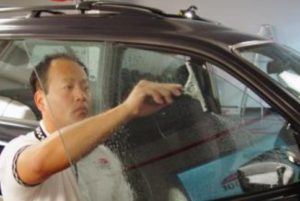 adhesive to temporarily “kill” the tackiness and provide some slip. Then they apply the adhesive side to the interior side of your door glass.
adhesive to temporarily “kill” the tackiness and provide some slip. Then they apply the adhesive side to the interior side of your door glass.
At this point, the tinting film is slippery, and the installer can position it however they want. Once it’s in place, they use a squeegee to push the water detergent mixture out from under the film which allows the adhesive to work. They start from the center of the glass and push the water detergent mixture and air bubbles toward the edges of the glass. Once the film is in place, they trim off the excess film with a sharp razor blade.
The installers can lift the film and re-wet it with water detergent to remove air bubbles or wrinkles, or they can apply a spray of water and alcohol to increase adhesion to the glass.
When they’re finished, some small air bubbles will remain. Those bubbles disappear over time. You’ll be instructed to leave the windows fully closed for two days to allow the adhesive to fully set. If you roll down your windows during the two day period, the film can peel off.
How to shop for car window tinting
Some car window tinting films are graded based on their visible light transfer (VLT). The rating can refer to the percentage of light that passes through the film. So a 20% film lets in 20% of the light. The lower the percentage, the darker the tint. However, some companies grade their car window tinting film based on how much light the film blocks, so their 20% film would block 20% of the light but allow 80% of the light through. Always check with the manufacturer or installer to see which definition of VLT they use to come up with their percentage.
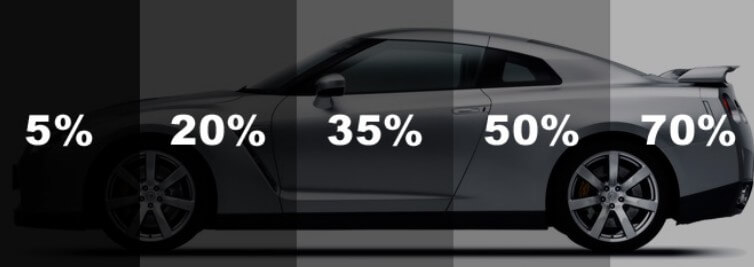
Window tint values are based on how much light the tint film lets in. The lower the number the less light it lets into your car
Every state has different regulations regarding the degree of window tinting allowed on the front and back side windows and the rear window. Plus, the specifications vary between cars, SUVs, and vans. In addition, some states restrict the tint film colors allowed as well as the reflectance characteristics. Most don’t allow mirrored or metallic films. If you are allowed to tint the rear window, many states require the dual-side mirror. Refer to this chart from the International Window Film Association for the laws in your state.
States also have varying laws requiring that the window film be certified for use in their state and also require a window sticker on each window stating the certification and the film grade. Still other states require the sticker to list the installer’s name and the name and address of the window film manufacturer.
Make sure the film tint you choose meets your state’s window tinting laws. Keep in mind that a darker film makes it harder for the driver to see at night. If you’re in an accident and claim that you could see the other car, pedestrian, or motorcycle, the injured party will certainly bring up the fact that your windows were tinted and that your decision to tint was negligent.
How much does window tinting cost
Only a handful of companies manufacture window tinting film. 3M is one of the largest and they’re also the most expensive. So the price you pay is directly related to the window film brand you choose. Price is also affected by the film’s warranty coverage. Window film and its adhesive are degraded by sunlight, eventually causing bubbles and wrinkles to appear. Window films with a longer warranty generally command a higher price.
Installation prices also vary by location. However, 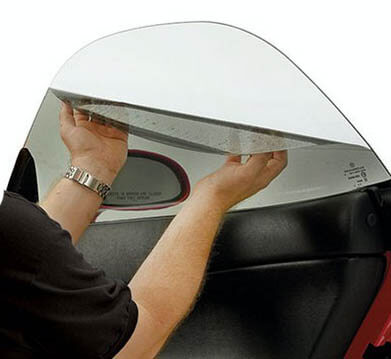 window film installers aren’t highly skilled laborers. Window film application for a typical sedan takes under two hours.
window film installers aren’t highly skilled laborers. Window film application for a typical sedan takes under two hours.
Windshield tinting costs an average of around $250 while tinting the windows on an average SUV runs about $600.
Avoid window tinting scams
If the price seems too low, it’s a scam. You’ll be upsold the minute you walk in the door. Or, you’ll be sold an inferior film or a film that’s not certified in your state. Inexpensive window film degrades rapidly and exhibits bubbles and wrinkles.
Some firms advertise a low price but inform you later that the price doesn’t include window preparation (cleaning and sticker removal). Make sure you ask about preparation charges before agreeing to the price.
Can you install window film yourself?
Yes, but it takes practice. There’s no way you’ll get good results on your first attempt. You’ll need two clean spray bottles, detergent, alcohol, glass cleaner, the proper squeegee, a supply of single-edge razor blades, an Exacto knife and blades, and microfiber towels.
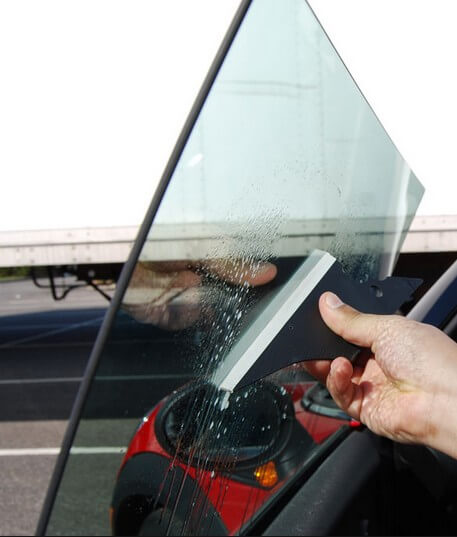
You can DIY window tint film after you’ve practiced on a few windows and screwed it up a few times. Just buy extra film
Plan on destroying enough film to do two full windows. Start by applying just a 8”x 8”section of window film and using the squeegee to remove the liquid and force out air bubbles. Next, apply a small patch at the edge of the window to get the hang of trimming the window film with a razor.
When you feel you’re ready, do one window at a time. Do NOT apply window film to all your windows, thinking that you’ll go back and remove the bubbles and wrinkles later.
The downsides of DIY car window tinting
As unfair as it may seem, you’ll probably be stopped by police more often.
You’ll be asked to show proof of the VLT of your particular window film, and the officer may question your proof.
©. 2017 Rick Muscoplat
Posted on by Rick Muscoplat